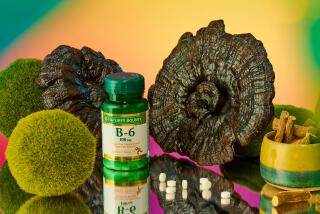Soft drink, with a twist of benzene?
- Share via
In the 1990s, a ruckus erupted in the beverage industry. Chemical tests revealed that benzene -- a cancer-causing chemical -- was present in Perrier water.
Today, benzene is again causing a stir in the world of bottled drinks. Class action lawsuits filed April 11 in Massachusetts and Florida claim that two beverage companies’ drinks have more benzene than the Environmental Protection Agency allows for water.
The lawsuits, filed by a Boston law firm, seek to stop the manufacturers from selling those drinks in those two states.
At high levels, benzene, an organic chemical found mostly in smog and gasoline, can cause cancer and other health ills.
Its presence in some soft drinks was noticed 15 years ago, when beverage industry chemists discovered that two soft drink ingredients -- ascorbic acid (vitamin C) and sodium benzoate (a preservative) -- could react at high temperatures to produce benzene. The industry worked with the FDA to reformulate products.
However, recent tests conducted by several independent consumers showed that at least some drinks still contain the chemical, especially after days of high-heat storage.
The plaintiffs said in a statement that in their independent tests, an East Coast beverage -- Polar Beverages’ Diet Orange Dry -- contained 9.1 parts per billion (ppb) benzene, almost twice as high as the EPA’s 5 ppb cap set for drinking water. They said another beverage -- BellyWashers 2/3 Less Sugar, manufactured by In Zone Brands, whose products are found nationwide -- contained 69 ppb.
“What was reported in the paper was considerably higher than anything In Zone has seen in their tests,” says Bob Hope, an In Zone Brands spokesman. But to be safe, In Zone will stop adding vitamin C to its drinks, he said.
Polar Beverages has stated that its tests of Diet Orange Dry found no benzene.
Robert Snyder, a professor of pharmacology and toxicology at Rutgers University in New Brunswick, N.J., says the jury’s out on whether ingesting benzene -- versus breathing it -- causes cancer.
People with benzene-related cancer have inhaled it in high amounts over a long time while working in industries, such as paint manufacturers, that use or make it.
Even if the benzene level in some soft drinks is above the mark for water, that does not mean the drinks are dangerous, says toxicology professor Martyn Smith of UC Berkeley. “We take in 100 to 200 micrograms per day of benzene from air pollution -- and one soft drink [with 5 to 10 ppb] would add 2 or 3 micrograms to this,” Smith says.
Still, “steps should be made to eliminate benzene in the drinks” as there’s no safe level, Smith says -- a point with which Snyder disagrees.
Chemists say that the testing methods used to determine the benzene level in soft drinks add to the confusion, because they can overestimate amounts of the chemical. The FDA, for example, found in earlier testing (with boiled samples) that a handful of drinks had benzene concentrations ranging from 20 ppb to 95 ppb. But baked pot roast scored 39 ppb, and raw bananas came in at 64 ppb.
In November, the FDA started testing a range of off-the-shelf drinks for benzene. Results will likely be released within the year, says Judy Kidwell, an FDA consumer safety officer. So far, she says, “the FDA does not believe benzene poses a concern.”
More to Read
Inside the business of entertainment
The Wide Shot brings you news, analysis and insights on everything from streaming wars to production — and what it all means for the future.
You may occasionally receive promotional content from the Los Angeles Times.










